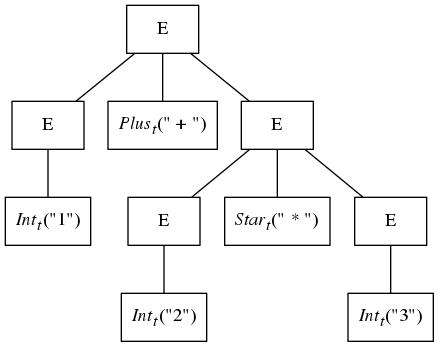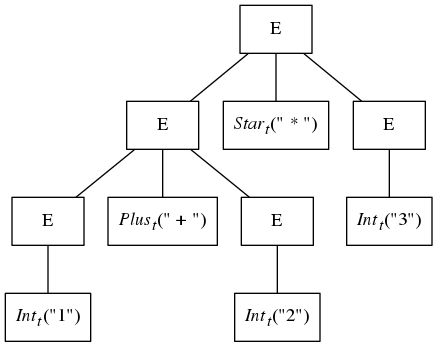Parsing
Parsing is the process of discovering the syntactic structure of the program in the linear (unstructured) sequence of tokens generated by the scanner. This syntactic structure is a tree in which tokens form the leaves of the tree. Interior nodes of the tree have types, called nonterminals, that specify certain grammatical categories. In an imperative programming language we may have nonterminals for statements, expressions, declarations, etc. These nodes are created by tree-constructing functions that take trees as input that become the child trees of the created tree.
Context free grammars are the formalism that is almost universally used for specifying the syntactically valid tree structures of a language. Grammars have the form
G = <NT, T, P, S>
where
- NT is a finite set of nonterminal symbols
- T is a finite set of terminal symbols
- P is a finite set of productions specifying how new trees can be created. These have the form NT → (NT | T )∗; a nonterminal on the left hand side specifying the type of the created tree and the possibly empty sequence of nonterminals and terminals on the right hand side specifying the types of the child trees.
- S is the grammar’s start symbol that indicates the type of nonterminal at the root of any tree representing a complete program. S ∈ NT.
Consider the following grammar for arithmetic expressions:
G = < NT = {E},
T = {Int_t, Plus_t, Star_t, LP_t, RP_t '+', '∗', '(', ')'},
P = { E → E '+' E,
E → E '∗' E,
E → '(' E ')',
E → Int_t }
S = E >
and the following sequence of tokens, possibly produced by a scanner.
[ Int_t("1"), Plus_t("+"), Int_t("2"), Star_t("∗"), Int_t("3") ]
The following syntax tree is a valid “parse tree” for this sequence of tokens as the tree conforms to the restrictions placed on the grammar.

While this tree is a perfectly fine representation of the structure in the sample expression, the following tree also conforms to the grammar and can be generated from the same set of sample tokens:

The problem is that the grammar given above is ambiguous. Such grammars have more than one tree for a given input and are thus not suited as grammars from which parsers can be built. The tree directly above has a shape that suggests that the addition will be done before the multiplication, and this violates the traditional operator precedence rules of arithmetic.
What is needed is a grammar that is non-ambiguous and enforces the rules of operator precedence and associativity. The grammar in Figure 1 satisfies these constraints and is written in the syntax of Silver. Silver syntax is somewhat different from the syntax of other parser generators. This is because it can be used in a more general manner since all of the attribute grammar specifications in Silver can be applied to concrete productions.
- Productions are named. These names are not often used for concrete productions, those
used by Copper to generate the parser, but they may be. The productions here all have
the
concretemodifier and are thus passed to Copper to be used in generating the parser. Abstract productions, indicated by theabstractkeyword are used for semantic analysis as described in the Attribute Grammars Section and are not passed to Copper for use in parser generation.
Semantic actions are allowed on concrete productions and are written between the curly braces. In Figure 1 these are elided.
- When terminals are constant their regular expression can be written using single quotes, as described above. In this case they can be referenced by the quoted string instead of the name of the terminal. This sometimes makes for easier reading of the productions.
Figure 1: Concrete syntax of dc.
nonterminal Root_c ;
concrete production root_c
r::Root_c ::= e::Expr_c { }
nonterminal Expr_c, Term_c, Factor_c ;
concrete production add_c
sum::Expr_c ::= e::Expr_c ’+’ t::Term_c { }
concrete production sub_c
dff::Expr_c ::= e::Expr_c ’-’ t::Term_c { }
concrete production exprTerm_c
e::Expr_c ::= t::Term_c { }
concrete production mul_c
prd::Term_c ::= t::Term_c ’*’ f::Factor_c { }
concrete production div_c
d::Term_c ::= t::Term_c ’/’ f::Factor_c { }
concrete production termFactor_c
t::Term_c ::= f::Factor_c { }
concrete production nested_c
e::Factor_c ::= ’(’ inner::Expr_c ’)’ { }
concrete production integerConstant_c
ic::Factor_c ::= i::IntLit_t { }
A parser is generated from a grammar (or collection of them) and the name of the nonterminal that is the start symbol for the grammar. This is the nonterminal that will appear at the root to the concrete syntax tree returned by the parser.
In Main.sv the following specification specifies a parser named parse
parser parse :: Root_c { dc; }.
The generated parser parse is a function that takes two strings, the text to parse and name of the
file which is then used in any error messages generated by the parser. This function returns a result
of type ParseResult<Root_c>. This is a parameterized nonterminal that defines three attributes:
parseSuccesswhich istrueif the text was successfully parsedparseTreewhich is the tree returned if the parse was successful. Forparsethis is a tree of typeRoot_c.parseErrorswhich is a string containing a description of the parse errors if the parse was not successful.
The file Main.sv also makes use of Silver’s rather esoteric input/output constructs defined in
the Running Silver Section.
Copper, like many parser generators,
also supports the specification of operator precedence and associativity as annotations on terminal
declarations. Examples of these types of specifications can be found in the Terminals.sv file of
the tutorial grammar simple:terminals and are explained in more detail in the Silver and Copper
reference manuals.
Copper generates LALR(1) parsers and context-aware scanners. Many compiler textbooks describe LALR(1) parsing and the challenges of specifying a grammar so that it falls into the LALR(1) class of grammars. When Copper reports a conflict, it is because the grammar is not LALR(1) and needs to be refactored to be in this class.
Readers that are serious about designing scanner and parsers need to read about LR parsing (which include LR(1) and LALR(1) parsing) to understand the underlying parsing algorithms.
Next Section: Attribute Grammars